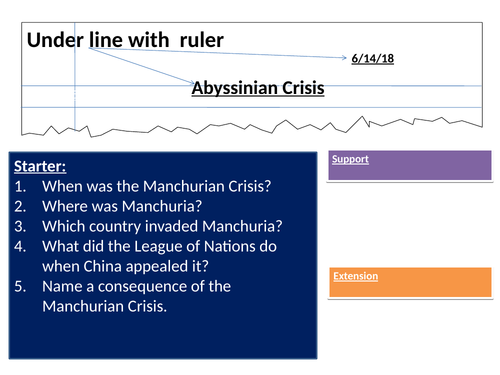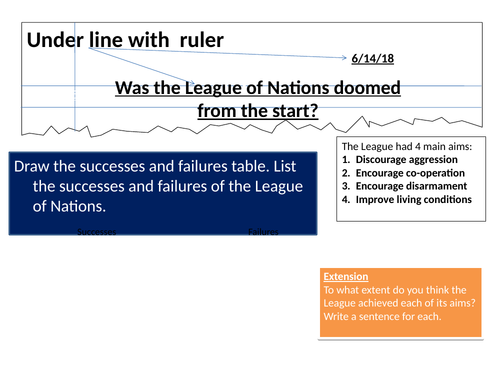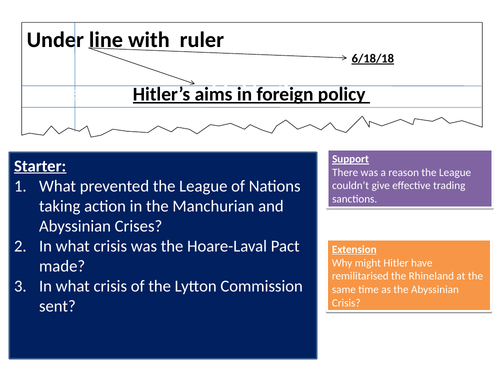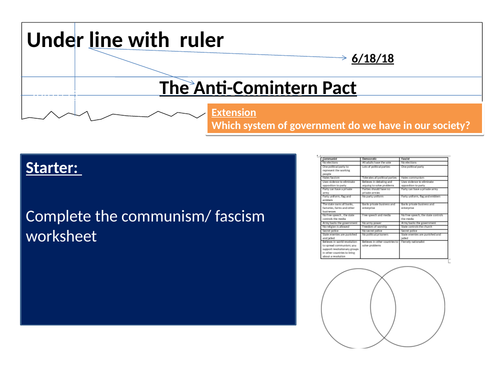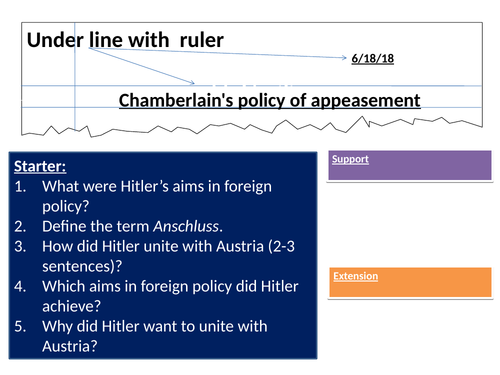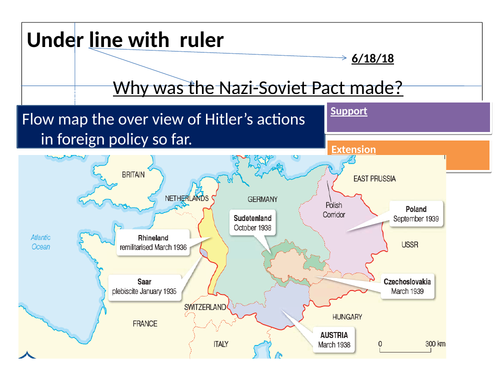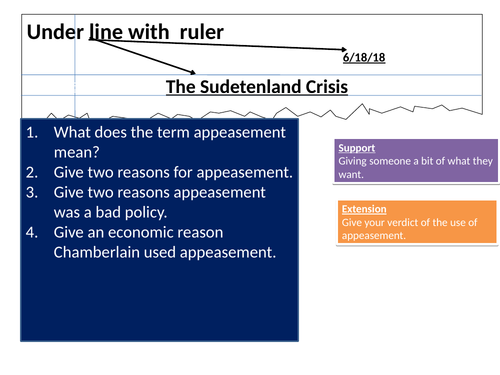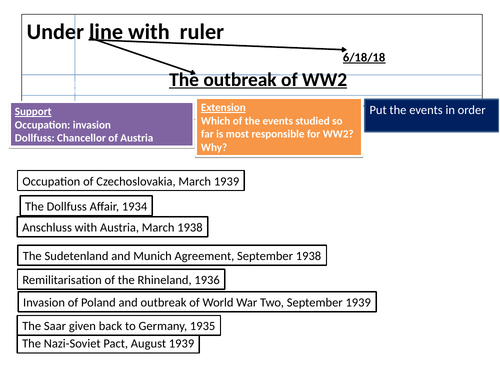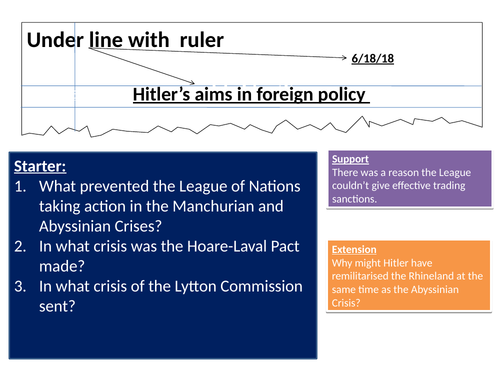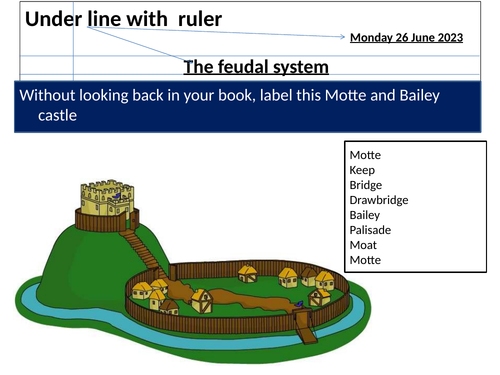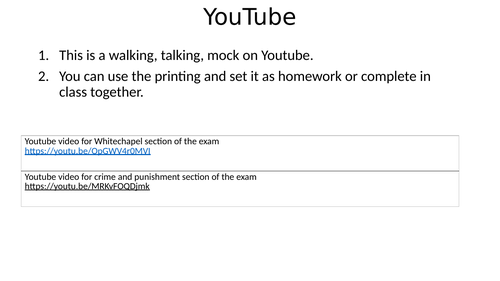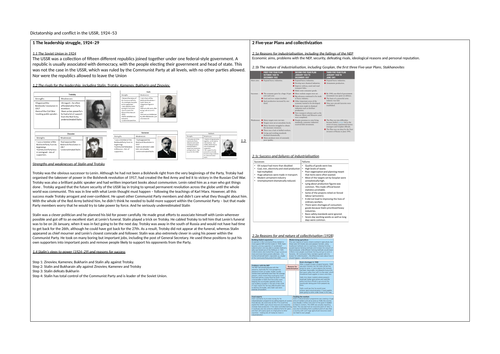65Uploads
14k+Views
20k+Downloads
All resources

Abyssinian Crisis
Two lessons on the Abyssininan Crisis.
A few resources taken from JohnDClare.
Used for IGCSE.

Was LoN doomed from start
Was the League of Nations (LoN) doomed from the start?
no textbook required.

Hitler's aims in foreign policy
Hitler’s aims in foreign policy.
Use for IGCSE.
No textbook required.

Edexcel History Elizabeth A3 revision sheets
Early Elizabethan England A3 revision sheet.
Could be used for cover lessons or as revision.
You will need the published textbook to go along with this.

Norman Conquest reading pack
Multiple reading packs are included in this download. It can be used in the replacement of a textbook or for homework. This makes differentiation easy as the packs are broken down into different reading ages of 13, 10, and 8, but contain all the same information.
PDFs and Word versions are included so that the packs are easy to edit.
Topics included:
Anglo-Saxon England.
Contenders to the throne.
The Battle of Hastings.
The Feudal system.
Motte and Bailey Castles.
Domesday Book.
Harrying of the North.
Significance of the Norman Conquest.

Norman Conquest (Unit of work): how did William take control of England?
Seven lessons including assessment lesson.
Each lesson includes reading and a clip from YouTube.
The reading is differentiated by reading age (Reading ages of 13, 10, and 8). You can swap out different reading packs, depending on ability. All packs are included.
Written SoW.
All lessons work towards the end question: how did William take control of England?

Edexcel Crime and Punishment Exam Revision
The 2021 exam paper has been used to show how to structure exam questions.
There is a Youtube tutorial of the Walking, talking, mock and printing to go along with it.
Youtube video for Whitechapel section of the exam: https://youtu.be/OpGWV4r0MVI
Youtube video for crime and punishment section of the exam: https://youtu.be/MRKvFOQDjmk
I have included the powerpoint I spoke over so that you are able to edit and change the answers as you seed fit.
The second ppt should be printed as a pack. As a teacher, you could then give your students the pack and get them to complete the activity at home ready for a similar exam.
The aim of this activity is to ensure that students understand what a good set of answers for paper 1.
You may also use this for content revision, but only the topics that appeared in the 2021 exam paper would feature.

Revision lesson Edexcel’s iGCSE Paper 1 (5) Dictatorship and conflict in the USSR, 1924 – 53
Revision lesson for entire until of iGCSE Paper 1 (5) Dictatorship and conflict in the USSR, 1924 – 53
This contains:
A powerpoint lesson
A blank revision sheet
A revision sheet with the answers on for self assessment.

Edexcel Cold War Key Topic 3
This series of lessons follows Edexcel’s Superpower relations and the Cold War, 1941–91. There are printable information sheets, but this can be esily substituted with the textbook.
Seven lessons in total with resources to print.
Invasion of Afghanistan and Carter
Detente (2 lessons)
Second Cold War
Gorbachev’s new thinking (2 lessons)
Fall of the Berlin Wall
Collapse of the SU and end of Warsaw
KT3 over view lessons with worksheet
KT3 exam questions with mark schemes
Every lesson starts of with 5 recall questions with the answers
Exam questions with the mark scheme are included
Self assessment is included.
Mark schemes are included on the ppts to make peer assessment easy.
Each each question relevant to KT3 is included in the exam question ppt. It is clear what part of th spec each exam question is referring to.

Henry VIII's Reformation (unit of work - KS3)
Six lessons, plus assessment.
- Lesson 1: What was the Reformation?
- Lesson 2: Henry VIII’s Great Matter
- Lesson 3: Break with Rome
- Lesson 4: Religious transformation of England.
- Lesson 5: Wealth and power
- Lesson 6: Why did Henry VIII divorce Rome (assessment planning lesson)
- Lesson 7: Assessment
Most lessons include reading and links to engaging videos on YouTube.
Reading Packs
Three different reading packs (reading ages of 13, 10, and 8).
Answers are included for each reading pack to allow quick self-assessment.
SoW
A written SoW is included. The SoW breaks down each lesson into three learning objectives with activities connected to each objective. All activities are included on each PowerPoint. This unit includes self assessment, peer-assessment and teacher assessment at the final lesson.
This is a plug-and-play lesson. No additional planning is needed. Just print the reading packs. Where there is reading in a lesson the 13-year reading age has been included in the PowerPoint. It is easy to swap this out for the self assessment part of the lesson

Cause of WW1 (unit of work) KS3
This is a Key Stage 3 scheme of work that aims to develop knowledge and a casual understanding of the Frist World War. There are seven lessons included, plus an assessment:
What was WW1?
Militarism
Alliances
Imperialism
Nationalism
Assassination and July Crisis
What caused WWI?
Assessment
Also, included is a knowledge organiser. There are 30 questions designed for pupils to use to self-study at home. These are then tested in every lesson until lesson 7. Included on the knowledge organiser is also a timeline of events and a list of keywords sorted into alphabetical order.
Starter activities are knowledge recall with elf assessment.
There are clear opportunities for peer assessment with examples of WWW and EBI that pupils are able to use.
Group work, individual work, and teacher-led learning are included as a part of the scheme of work.
Reading materials are included in the lesson. Militarism and alliances include a choice of reading that is at reading age 10 or 12. Both include self assessment.

Cambridge IGCSE History B
iGCSE Cambridge (CIE) History Core Content B
This is a series of lessons that covers Core content: Option B
The twentieth century: international relations from 1919
This is the Cambridge iGCSE History (CIE)
• Each lesson starts with five recall questions that are self assess (answers are on the next slide)
• The lessons cover the spec for Core Content B, Cambridge iGCSE, for exams in 2024, 2025, and 2026
• Clear learning objectives in each lesson.
• NO TEXTBOOK is required for these lessons, but that does occasionally you need to print the materials that come with the lessons.
Lessons included:
1 Was the Treaty of Versailles fair?
1.1 aims of the Big Three
1.2 Treaty of Versailles
1.3 Political impact of ToV on Germany
1.4 Economic and social impact of ToV on Germany
1.5 Contemporary opinions about ToV
2 To what extent was the League of Nations a success
2.1 Structure of the League of Nations
2.2 Success and failures of the LoN
2.3 LoN’s humanitarian work
2.4a Manchuria (events and causes)
2.4b Manchuria (consequences)
2.4c Manchuria source questions
2.5a Abyssinian Crisis (events and causes)
2.5b Abyssinian Crisis Abyssinian consequences
2.5c Abyssinian source Qs
3 How far was Hitler’s foreign policy to blame for the outbreak of war in Europe in 1939?
3.1 Hitler’s Aims in foreign policy
3.2 Rhineland, Saar and rearmament
3.3 Spanish Civil War and Anti-Conmintern Pact
3.4 Appeasement and Rome-Berlin Axis
3.5 Anschluss
3.6 Sudetenland and Munich Agreement
3.7 Nazi-Soviet Pact
3.8 Why did peace collapse?
4 Who was to blame for the Cold War?
4.1 End of WW2
4.2 Yalta
4.3 Potsdam
4.4 Soviet expansion
4.5 USA’s reaction to Soviet expansion
4.6Berlin blockade and airlift
4.7 NATO and Warsaw
4.8 Who was to blame for the Cold War?
5 How effectively did the United States contain the spread of communism?
5.1 Causes of the Korean War
5.2 Events of the Korean War
5.3 Cuban Crisis
5.4 consequences of the Cuban Crisis
5.5 Vietnam
5.6 Involvement in Vietnam war
5.7 Events of the Vietnam War
5.8 Causes of the Vietnam War
5.9 Summary of Vietnam
6 How secure was the USSR’s control over Eastern Europe, 1948–c.1989?
6.1 Hungary
6.2 Resistance Czechoslovakia
6.3 Comparing and contrasting resistance in Hungary and Czechoslovakia
6.4 Berlin Wall
6.5 Poland and solidarity
6.6 Gorbachev

Cambridge iGCSE Russia, 1905 – 41 (depth study C)
This Unit of work covers the Cambridge (CIE) iGCSE Depth study C) Russia, 1905 – 41.
28 lessons are included.
Exam questions have been matched up to topics and are at the end of the ppts with the mark schemes.
Each lesson has three learning objectives.
No specific textbook needed. All printable materials are included.
Lessons covers the entire spec and include:
1.1 Tsarist rule in Russia
1.2 1905 Revolution
1.3 Attempts at reform
1.4a Effects of WW1 on Russia
1.4b Influence of Rasputin
1.5 March 1917 Revolution
2.1 Provisional Government
2.2 Failure of the Provisional Government
2.3a Lenin and the Bolsheviks
2.3b Bolshevik seizure of power
2.4a Civil War
2.4b Reasons for the Bolshevik victory
2.4c War communism
2.5a The Kronstadt Naval Mutiny NEED MULTIFLOW
2.5b New economic policy
2.6 Lenin’s death
3.1 Reasons for Stalin’s emergence as leader by 1928
3.2 Stalin’s use of Terror
3.3 Propaganda and official culture
3.4 the Purges
4.1 Causes of the modernisation of Soviet economy
4.2a five-year plans
4.2b Successes and failures of the 5 year plans
4.3a Collectivisation
4.3b opposition to collectivisation
4.3c Successes and failures of collectivisation
4.4 Different experience of social groups
4.5 Women int he USSR

CIE Cambridge IGCSE History The First World War, 1914–18
Series of lessons that covers iGCSE history, CIE Cambridge, paper 1, Depth study A, The First World War, 1914–18 (World War One, WW1)
Relevant exam questions, with mark schemes, are included at the end of lesson
Exam Map shows what is on the spec and when it was examined. This allows you to easily find exam Qs by topic.
Section 2 (To what extent was it a world war?) has never been examined, but it’s on the spec, so lessons included.
All resources are provided so no textbook is required:
1.1 Schlieffen Plan
1.2 Why did the Schlieffen Plan fail
1.3 Stalemate
1.4 Trench warfare
1.5 New weapons and methods
1.6 Verdun
1.7 Somme
2.1 British Empire on the Western Front
2.2 the war in Africa
2.3 Contribution of Japan
2.4 The Arab revolt
3.1 German threat in North Sea
3.2 Gallipoli Campaign
3.3 Eastern front and Russia leaves
3.4 The impact of war on civilian populations
4.1 Ludendorff Offensive & defeat of Germany
4.2 Hundred Days
4.3 Conditions in Germany towards the end of the war
4.4 The Armistice

